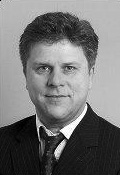Profile
-
OrganizationUniversity of Wisconsin - Milwaukee
-
Telephone(414) 229-4338
-
Address(s)Marius Schmidt
UW-Milwaukee Physics Department, Kenwood Interdisciplinary Research Complex (KIRC( Room 3087
3135 North Maryland Avenue
Milwaukee, WI 53211
-
Biography
Marius Schmidt is using physical methods to investigate biological molecules. He is concentrating mainly on static and time-resolved macromolecular crystallography to investigate the structure, dynamics and kinetics of proteins. Dr. Schmidt is also developing new, sophisticated software for the analysis of the time-resolved (4-dimensional) X-ray data. Results from crystallography are corroborated by (time or energy resolved) spectroscopic methods. Dr. Schmidt obtained his Dipl. in Biology in 1990 at Johannes-Gutenberg-University, Mainz (Germany). He received his Dr. rer. Nat. in 1996 at Technische Universität München, Garching (Germany), where later he became habilitated in Experimental Physics in 2004. In 2008, he obtained a habilitation in the French system in Theoretical, Physical and Analytical Chemistry. From 1996 to 1998, Dr. Schmidt worked as a scientist for the Physics Department at Technische Universität München (Germany) and from 1998 to 2001, as a research associate for the Department of Biochemistry and Molecular Biology at the University of Chicago. From 2001 to 2007, he worked as a scientist and privatdozent for the Physics Department at Technische Universität München (TUM), (Germany). Dr. Schmidt has been on faculty at the University of Wisconsin-Milwaukee since 2007. Dr. Schmidt’s lab, as part of the BioXFEL Center, will work on time-resolved studies on photoactive proteins and enzymes at near-atomic resolution. The time-resolution varies between fs to observe the earliest events in laser activated reactions, and ns and longer to investigate enzymatically catalyzed reactions. They will employ time-resolved serial femtosecond (nano) crystallography (TR-SFX), as well as time-resolved X-ray scattering from solution to determine atomic structures of transient intermediates of these reactions.




